-

新人教版高中英语选修2Unit 3 Using langauge-Listening教学设计
1. How is Hunan cuisine somewhat different from Sichuan cuisine?The heat in Sichuan cuisine comes from chilies and Sichuan peppercorns. Human cuisine is often hotter and the heat comes from just chilies.2.What are the reasons why Hunan people like spicy food?Because they are a bold people. But many Chinese people think that hot food helps them overcome the effects of rainy or wet weather.3.Why do so many people love steamed fish head covered with chilies?People love it because the meat is quite tender and there are very few small bones.4.Why does Tingting recommend bridge tofu instead of dry pot duck with golden buns?Because bridge tofu has a lighter taste.5 .Why is red braised pork the most famous dish?Because Chairman Mao was from Hunan, and this was his favorite food.Step 5: Instruct students to make a short presentation to the class about your choice. Use the example and useful phrases below to help them.? In groups of three, discuss what types of restaurant you would like to take a foreign visitor to, and why. Then take turns role-playing taking your foreign guest to the restaurant you have chosen. One of you should act as the foreign guest, one as the Chinese host, and one as the waiter or waitress. You may start like this:? EXAMPLE? A: I really love spicy food, so what dish would you recommend?? B: I suggest Mapo tofu.? A: Really ? what's that?

新人教版高中英语选修2Unit 4 Learning about Language教学设计
This section guides students to pay attention to the typical context of vocabulary use, helps students accumulate vocabulary around the key vocabulary of this unit, and uses the learned words and word chunks in different contexts to deeply understand their meaning and usage, so as to achieve the purpose of review and consolidation.The teaching design activities aim to guide students to pay attention to the typical context in which the target vocabulary is used, as well as the common vocabulary used in collocation, so that students can complete the sentence with correct words. In terms of vocabulary learning strategies, this unit focuses on cultivating students' ability to pay attention to collocation of words and to use word blocks to express meaning.For vocabulary learning, it is not enough just to know the meaning of a single word, but the most important thing is to master the common collocations of words, namely word blocks.Teachers should timely guide students to summarize common vocabulary collocation, such as verb and noun collocation, verb and preposition collocation, preposition and noun collocation, and so on.1. Guide students to understand and consolidate the meaning and usage of the vocabulary in the context, 2. Guide the students to use the unit topic vocabulary in a richer context3. Let the students sort out and accumulate the accumulated vocabulary, establishes the semantic connection between the vocabulary,4. Enable students to understand and master the vocabulary more effectivelyGuiding the Ss to use unit topic words and the sentence patterns in a richer context.

新人教版高中英语选修2Unit 4 Reading for writing教学设计
假定你是英国的Jack,打算来中国旅行,请你给你的中国笔友李华写一封信,要点如下:1.你的旅行计划:北京→泰山→杭州;2.征求建议并询问他是否愿意充当你的导游。注意:1.词数80左右(开头和结尾已给出,不计入总词数);2.可以适当增加细节,以使行文连贯。参考词汇:故宫 the Forbidden City;泰山 Mount TaiDear Li Hua,I'm glad to tell you that 'm going to visit China.First,I am planning to visit Beijing,the capitalof China,where I am looking forward to enjoying the Great Wall,the Forbidden City and somebeautiful parks.Then I intend to go to visit Mount Tai in Shandong Province.I've heard that it is one ofthe most famous mountains in China and I can't wait to enjoy the amazing sunrise there.After that,I amalso going to Hangzhou.It is said that it is a beautiful modern city with breathtaking natural sights,among which the West Lake is a well- known tourist attraction.What do you think of my travel plan? Will you act as my guide? Hope to hear from you soon.

新人教版高中英语选修2Unit 4 Using langauge-Listening教学设计
The theme of the listening section is " talking about scenery and culture along a journey."The part is designed to further lead the students to understand Canadian natural geography and social environment, and integrated into the cultural contrast by mentioning the long train journey from Beijing to Moscow routes. On this basis, the part activates students related travel experience, lets the student serial dialogue, guides the student to explore further the pleasure and meaning of the long journey, and Chinese and foreign cultural comparison.The part also provides a framework for the continuation of the dialogue, which is designed to provide a framework for students to successfully complete their oral expressions, and to incorporate an important trading strategy to end the dialogue naturally.1. Help students to understand and master some common English idioms in the context, and experience the expression effect of English idioms.2. Guide the students to understand the identity of different people in the listening context, and finish the dialogue according to their own experience.3. Instruct the students to use appropriate language to express surprise and curiosity about space and place in the dialogue, and master the oral strategy of ending the dialogue naturally.1. Instruct students to grasp the key information and important details of the dialogue.2. Instruct students to conduct a similar talk on the relevant topic.

新人教版高中英语选修2Unit 5 Learning about Language教学设计
The purpose of this section of vocabulary exercises is to consolidate the key words in the first part of the reading text, let the students write the words according to the English definition, and focus on the detection of the meaning and spelling of the new words. The teaching design includes use English definition to explain words, which is conducive to improving students' interest in vocabulary learning, cultivating their sense of English language and thinking in English, and making students willing to use this method to better grasp the meaning of words, expand their vocabulary, and improve their ability of vocabulary application. Besides, the design offers more context including sentences and short passage for students to practice words flexibly.1. Guide students to understand and consolidate the meaning and usage of the vocabulary in the context, 2. Guide the students to use the unit topic vocabulary in a richer context3. Let the students sort out and accumulate the accumulated vocabulary, establishes the semantic connection between the vocabulary,4. Enable students to understand and master the vocabulary more effectivelyGuiding the Ss to use unit topic words and the sentence patterns in a richer context.Step1: Read the passage about chemical burns and fill in the blanks with the correct forms of the words in the box.

新人教版高中英语选修2Unit 5 Reading and thinking教学设计
The theme of this activity is to learn the first aid knowledge of burns. Burns is common in life, but there are some misunderstandings in manual treatment. This activity provides students with correct first aid methods, so as not to take them for granted in an emergency. This section guides students to analyze the causes of scald and help students avoid such things. From the perspective of text structure and collaborative features, the text is expository. Expository, with explanation as the main way of expression, transmits knowledge and information to readers by analyzing concepts and elaborating examples. This text arranges the information in logical order, clearly presents three parts of the content through the subtitle, accurately describes the causes, types, characteristics and first aid measures of burns, and some paragraphs use topic sentences to summarize the main idea, and the level is very clear.1. Guide students to understand the causes, types, characteristics and first aid methods of burns, through reading2. Enhance students’ ability to deal withburnss and their awareness of burns prevention3. Enable students to improve the ability to judge the types of texts accurately and to master the characteristics and writing techniques of expository texts.Guide students to understand the causes, types, characteristics and first aid methods of burns, through readingStep1: Lead in by discussing the related topic:1. What first-aid techniques do you know of ?CPR; mouth to mouth artificial respiration; the Heimlich Manoeuvre

新人教版高中英语选修2Unit 5 Using langauge-Listening教学设计
The theme of this section is to learn how to make emergency calls. Students should learn how to make emergency calls not only in China, but also in foreign countries in English, so that they can be prepared for future situations outside the home.The emergency telephone number is a vital hotline, which should be the most clear, rapid and effective communication with the acute operator.This section helps students to understand the emergency calls in some countries and the precautions for making emergency calls. Through the study of this section, students can accumulate common expressions and sentence patterns in this context. 1.Help students accumulate emergency telephone numbers in different countries and learn more about first aid2.Guide the students to understand the contents and instructions of the telephone, grasp the characteristics of the emergency telephone and the requirements of the emergency telephone.3.Guide students to understand the first aid instructions of the operators.4.Enable Ss to make simulated emergency calls with their partners in the language they have learned1. Instruct students to grasp the key information and important details of the dialogue.2. Instruct students to conduct a similar talk on the relevant topic.Step1:Look and discuss:Match the pictures below to the medical emergencies, and then discuss the questions in groups.
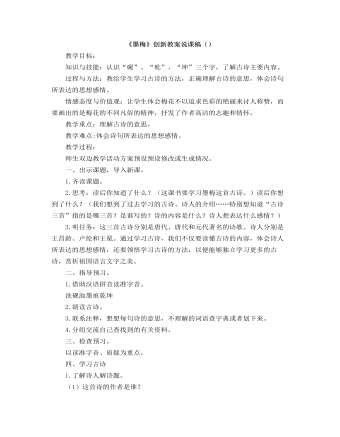
部编人教版四年级下册《古诗词三首》创新教案
二、指导预习。 1.借助汉语拼音读准字音。洗砚池墨痕乾坤2.朗读古诗。3.联系注释,想想每句诗的意思,不理解的词语查字典或者划下来。4.分组交流自己查找到的有关资料。三、检查预习。以读准字音、质疑为重点。四、学习古诗1.了解诗人解诗题。(1)这首诗的作者是谁?(2)《墨梅》作者:元代著名画家王冕。王冕(公元1287——1359)我国元代著名画家。字元章,号煮石山农,诸暨人(今浙江绍兴)。(3)这首诗的题目是什么?(墨梅。这是一首题画诗。墨梅,顾名思义,即为用水墨画的梅花。)(4)从题目上,你知道了什么?还想知道什么?(知道了这首诗写的是水墨画的梅花。想知道这幅梅花图是谁画的?墨梅有什么特点?诗人为什么要写《墨梅》这首诗?要表达自己什么样的感情?)
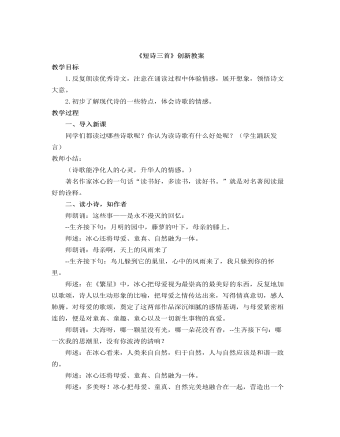
部编人教版四年级下册《 短诗三首》创新教案
教学目标1.反复朗读优秀诗文,注意在诵读过程中体验情感,展开想象,领悟诗文大意。2.初步了解现代诗的一些特点,体会诗歌的情感。教学过程一、导入新课同学们都读过哪些诗歌呢?你认为读诗歌有什么好处呢?(学生踊跃发言)教师小结:(诗歌能净化人的心灵,升华人的情感。)著名作家冰心的一句话“读书好,多读书,读好书。”就是对名著阅读最好的诠释。
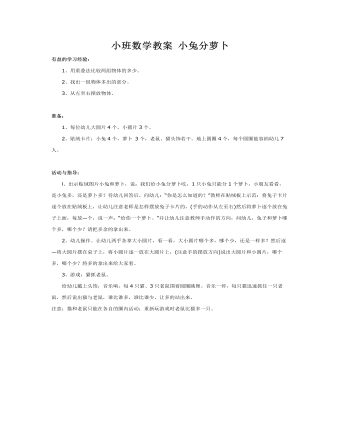
小班数学教案 小兔分萝卜
2、找出一组物体多出的部分。3、从左至右摆放物体。 准备:1、每位幼儿大圆片4个,小圆片3个。2、贴绒卡片:小兔4个,萝卜 3个,老鼠、猫头饰若干。地上圆圈4个,每个圆圈能容纳幼儿7人。 活动与指导:l、出示贴绒图片小兔和萝卜,说:我们给小兔分萝卜吃,1只小兔只能分1个萝卜,小朋友看看,是小兔多,还是萝卜多?待幼儿回答后,问幼儿:“你是怎么知道的?”教师在贴绒板上示范:将兔子卡片逐个放在贴绒板上,让幼儿注意老师是怎样摆放兔子卡片的,(手的动作从左至右)然后将萝卜逐个放在兔子上面,每放—个,说一声:“给你一个萝卜。”并让幼儿注意教师手动作的方向,问幼儿,兔子和萝卜哪个多,哪个少?请把多余的拿出来。
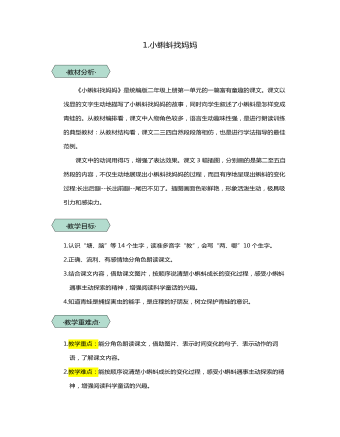
统编版二年级语文上第1课小蝌蚪找妈妈教学设计教案
《小蝌蚪找妈妈》是统编版二年级上册第一单元的一篇富有童趣的课文。课文以浅显的文字生动地描写了小蝌蚪找妈妈的故事,同时向学生叙述了小蝌蚪是怎样变成青蛙的。从教材编排看,课文中人物角色较多,语言生动趣味性强,是进行朗读训练的典型教材:从教材结构看,课文二三四自然段段落相仿,也是进行学法指导的最佳范例。课文中的动词用得巧,增强了表达效果。课文3幅插图,分别画的是第二至五自然段的内容,不仅生动地展现出小蝌蚪找妈妈的过程,而且有序地呈现出蝌蚪的变化过程:长出后腿--长出前腿--尾巴不见了。插图画面色彩鲜艳,形象活泼生动,极具吸引力和感染力。 1.认识“塘、脑”等14个生字,读准多音字“教”,会写“两、哪”10个生字。2.正确、流利、有感情地分角色朗读课文。3.结合课文内容,借助课文图片,按顺序说清楚小蝌蚪成长的变化过程,感受小蝌蚪遇事主动探索的精神,增强阅读科学童话的兴趣。4.知道青蛙是捕捉害虫的能手,是庄稼的好朋友,树立保护青蛙的意识。 1.教学重点:能分角色朗读课文,借助图片、表示时间变化的句子、表示动作的词语,了解课文内容。2.教学难点:能按顺序说清楚小蝌蚪成长的变化过程,感受小蝌蚪遇事主动探索的精神,增强阅读科学童话的兴趣。 2课时
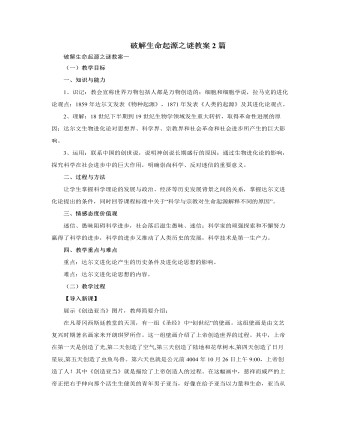
人教版高中历史必修3破解生命起源之谜教案2篇
设问:你怎么看待这个问题的?(这是达尔文没有想到的,是有人利用了达尔文的学说,科学应该与其区分开来,但是科学家在研究时,既要做到为追求真理不断探索,又要有一定的人文精神,比如我们只有以人为本,才能找到解决当今社会面临的诸如环保、战争、饥荒等问题的途径,才能构建防止核物理技术、克隆技术、信息技术、生物技术、太空技术等可能对人类造成不可逆转的破坏作用的思想基础、决策机制和社会条件。更重要的是社会和国家应该对此有足够的认识,正因为此,所以现在当一项科学发明出台后,就会有一些法律出台,限制其可能的非人道用途。但是这些影响应不成为我们进行科学探究的阻碍。)(3)科学与宗教的斗争设计意图:再次引导学生认识,科学的探索永无止境,同时也再次认识宗教和科学理论产生的原因。材料1:1972年,美国加利福尼亚教育部竟明文规定,中学生物学课本除进化论外,必须还有神创论的内容,而且两者的页数要各占一半。
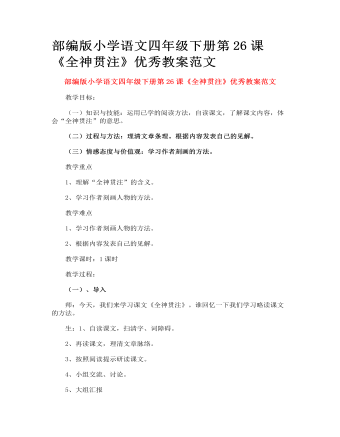
部编版小学语文四年级下册第26课《全神贯注》优秀教案范文
(一)、导入 师:今天,我们来学习课文《全神贯注》。谁回忆一下我们学习略读课文的方法。 生:1、自读课文,扫清字、词障碍。 2、再读课文,理清文章脉络。 3、按照阅读提示研读课文。 4、小组交流、讨论。 5、大组汇报 (二)、按照学习方法,进行学习。 (三)、(以小组为单位)汇报学习情况。 1、小组1:读课文,并讲解不理解的词义。 提醒易读错的字音和易写错的生字。
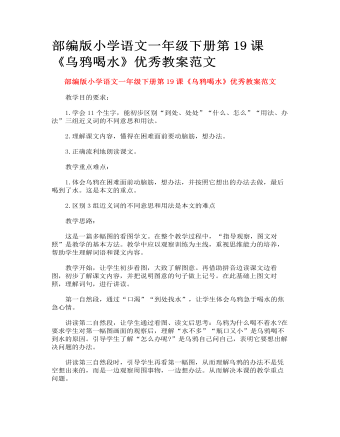
部编版小学语文一年级下册第19课《乌鸦喝水》优秀教案范文
教学思路: 这是一篇多幅图的看图学文。在整个教学过程中,“指导观察,图文对照”是教学的基本方法。教学中应以观察训练为主线,重视思维能力的培养,帮助学生理解词语和课文内容。 教学开始,让学生初步看图,大致了解图意。再借助拼音边读课文边看图,初步了解课文内容,并把说明图意的句子做上记号。在此基础上图文对照,理解词句,进行讲读。 第一自然段,通过“口渴”“到处找水”,让学生体会乌鸦急于喝水的焦急心情。 讲读第二自然段,让学生通过看图、读文后思考:乌鸦为什么喝不着水?在要求学生对第一幅图画面的观察后,理解“水不多”“瓶口又小”是乌鸦喝不到水的原因。引导学生了解“怎么办呢?”是乌鸦自己问自己,表明它要想出解决问题的办法。 讲读第三自然段时,引导学生再看第一幅图,从而理解乌鸦的办法不是凭空想出来的,而是一边观察周围事物,一边想办法。从而解决本课的教学重点问题。
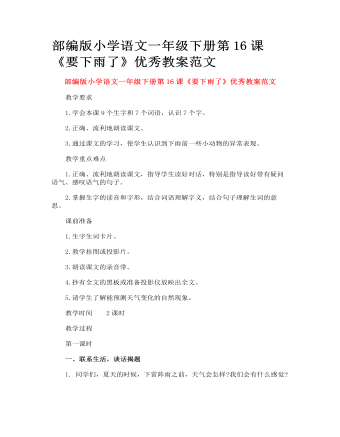
部编版小学语文一年级下册第16课《要下雨了》优秀教案范文
由扶到放,学习课文 1.指导学习一至三段。 (1)指名读第一段。学习生字"弯、直",通过做动作理解词义。 (2)练习朗读第一段,可边读边做动作。 (3)教师引读第二段:小燕子从他头上飞过。小白兔大声喊--(学生读)。 (4)引导学生看第一幅挂图:小燕子飞得很低,小白兔奇怪地向燕子为什么飞得这么低。学生练习朗读小白兔喊叫的句子,提醒学生注意提示语"大声喊"和句尾问号。 (5)先指名读第三段,然后逐句以问引读: ① 教师指第一句问:燕子边飞边说-- ②空气怎么样呢--(学生接读第二句)虫子的翅膀可比鸟的翅膀小多了,薄多了,就像透明的纱一样,沾上了小水珠,就像人背上了铅球一样沉重,自然就飞不高了。再读第二句。 ③那小燕子飞不高是什么原因呢?学生读最后一句,教师板书:捉虫子,学习生字"捉",练习朗读句子。
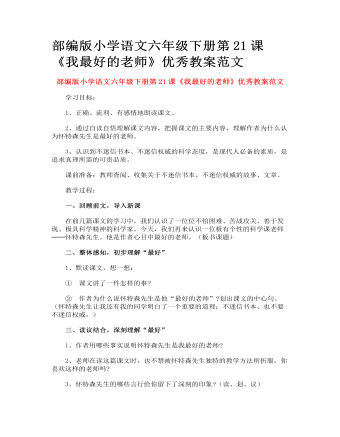
部编版小学语文六年级下册第21课《我最好的老师》优秀教案范文
嗅苹果 学生们向苏格拉底请教:怎样才能坚持真理? 笑容可掬的苏格拉底让大家坐下来,随后取出一个苹果。他用手指捏着,慢慢地从每个同学的座位旁边走过,一边走一边说:“请同学们集中精力,注意嗅一嗅空气中的气味。” 然后,他回到讲台上,把苹果举起来左右晃了晃,问:“哪位同学闻到了苹果的气味儿?” 有一位同学举手回答:“我闻到了,是香味!” 苏格拉底再次走下讲台,举着苹果,慢慢地从每一个学生的座位旁边走过,边走边叮嘱:“请同学务必集中精力,仔细嗅一嗅空气中的气味。” 稍停,苏格拉底第三次从讲台走到学生们中间,让每一个学生再嗅一嗅苹果的气味。
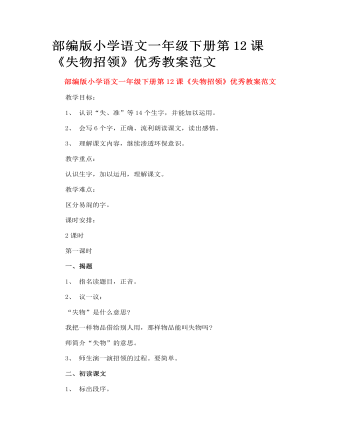
部编版小学语文一年级下册第12课《失物招领》优秀教案范文
读课文,感悟 1、 齐读第一自然段。 2、 你知道了什么时间什么人去干什么? 3、 植物园怎么样?同学们参观认真吗?你怎么知道的? 4、 指名读第一自然段,创设情境比比谁读得更棒。注意“可”要读出抑扬感。 5、 接下来的3、4、5、6自然段朗读,师读旁白,学生只要读说的一句话,但要结合叙述加进动作、表情等等。 6、 小组内练习,师巡视指导。 7、 各自读第7自然段,说说如果当时是自己在场会怎样想,怎样做。 8、 齐读第8自然段,师提示“会心的微笑”处要读得缓慢、高兴。 9、 讨论“会心的微笑”是什么意思,适当扩展。 10、 自荐读,比比谁读得更生动(从语音、语气、表情等方面评价)。 11、 各自读课文,要求: 完整、仔细,觉得有意思的地方多读读。努力读出自己的最佳样子。

部编版小学语文二年级下册第8课《彩色的梦》优秀教案范文
创设情境,引入梦境。师:想到能给你们上课,我昨晚兴奋的睡不着觉,迷迷糊糊的我好像进入到了一个奇妙的世界:我脚踏星星来到学校,我们的课堂飞到了天空,云朵变成了小朋友的课桌,而老师的讲台竟是一道七色的彩虹。太阳和月亮为我们照明,小动物们争着来听课,小朋友们挥舞着画笔把天空变成了美丽的花园。你们觉得老师的梦怎么样?生:神奇、甜美。师:梦可以带给我们许多新奇的体验。引出课题《多彩的梦》师:那谁来说说你印象深刻的梦?
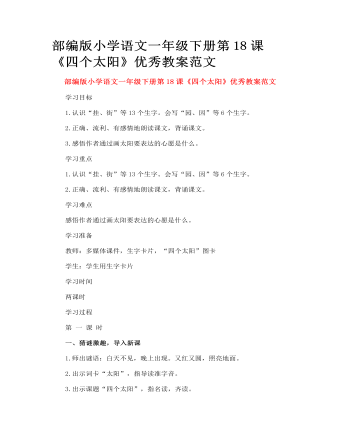
部编版小学语文一年级下册第18课《四个太阳》优秀教案范文
感悟理解,感情朗读 1.生再读课文后指名分自然段接读课文。 2.你们知道文中的小男孩分别为四季画了哪四个不同颜色的太阳吗?用“──”在文中划出。 3.指名发言,指导练读“绿绿的太阳”“金黄的太阳”“红红的太阳”“彩色的太阳” 师贴板画:“绿绿的太阳”“金黄的太阳”“红红的太阳”“彩色的太阳” 4.你最喜欢哪个季节的太阳呢? 同桌互读描写你最喜欢的那个季节的太阳的自然段 5.指名朗读,感悟理解 春天──多彩的太阳 1.指名读 2.指名再读,喜欢的齐读 3.你们看到的春天的色彩都有哪些? 4.师生合作读 夏天──绿绿的太阳 1.指名读 2.出示课件:高山、田野、街道、校园到处一片清凉。 指导朗读该句 3.男女生比读
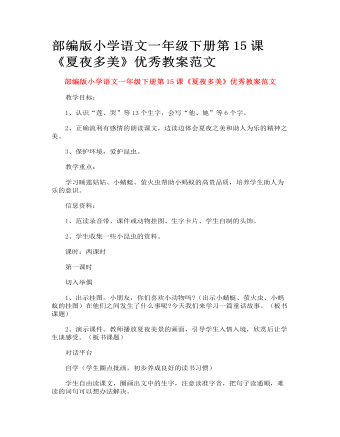
部编版小学语文一年级下册第15课《夏夜多美》优秀教案范文
1、检查读。教师以开火车的形式让学生按自然段读课文,看谁读得既正确又流利。 2、指正读。把你喜欢的小动物的话找出来读一读,教师随机指导。 3、想象读。先听范读录音,然后指名读文,边读边想象当时的情景。 4、分角色读。教师指导学生研究讨论每个角色的语气怎样读,并尝试给这些角色设计表情动作。 如:睡莲姑姑(奇怪的问):“小蚂蚁,你怎么了?” 小蚂蚁(揉肉眼睛,伤心的)说:“我不小心掉进池塘,上不了岸啦!” (让学生尝试添加提示语,是一个大胆的尝试。让学生根据生活经验和对课文的理解,给“人物”设计表情动作,添加不同的语气词,使课文变成了童话剧。由于是自己创造的成果,学生会读得有情有趣,有滋有味。但这种能力的培养不是一朝一夕的,教师要有意识的加以引导。)

